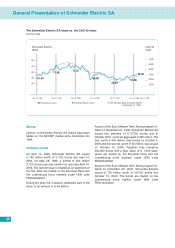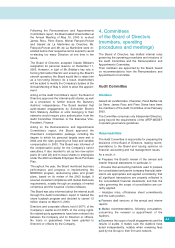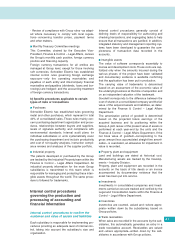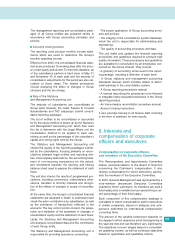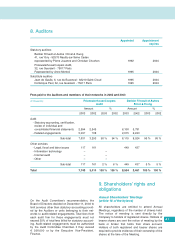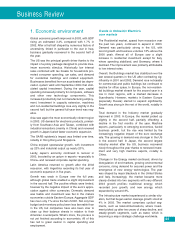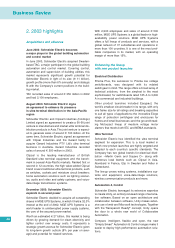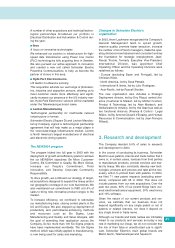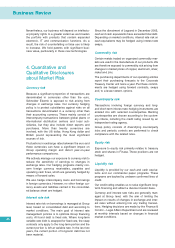APC 2003 Annual Report Download - page 38
Download and view the complete annual report
Please find page 38 of the 2003 APC annual report below. You can navigate through the pages in the report by either clicking on the pages listed below, or by using the keyword search tool below to find specific information within the annual report.
The internal auditors are responsible for ensuring at
the level of each unit that:
■Risks are appropriately identified and managed.
■Significant financial, managerial and operating
information is accurate, reliable and timely.
■Employees' actions are in compliance with policies,
standards, procedures and applicable laws and reg-
ulations.
■Resources are acquired economically, used effi-
ciently and adequately protected.
Internal audit plans are drawn up based on risk and
control concerns identified by management, taking
into account the work performed by the external
auditors. In light of Schneider Electric's core busi-
nesses, internal audit procedures focus mainly on
revenue recognition, cash and asset management
processes, wages and benefits, financial reporting,
information systems, manufacturing operations, pur-
chasing and operating expenses.
After each internal audit, a report is issued setting
out the auditors' findings and recommendations.
Copies of the report are given to the head of the
audited entity, General Management and the Audit
Committee.
Internal benchmarks
a) Principles of Responsibility
The Principles of Responsibility are a set of guide-
lines for decisions and actions that have an impact
on stakeholders –employees, customers, suppliers,
shareholders, the community– or the environment. A
copy of the Principles is given to all new employees
along with their employment contract.
b) Insider Code
This code sets out the rules to be followed by man-
agement and employees to prevent insider trading. It
imposes an obligation of confidentiality on all
employees who have access to price-sensitive infor-
mation and sets permanent restrictions on purchas-
es and sales of Schneider Electric shares by persons
who have access to price-sensitive information in the
course of their work.
c) International Internal Auditing Standards
The Schneider Electric internal auditors are commit-
ted to complying with the international auditing stan-
dards published by the Institute of Internal Auditors
(I.A.A.) and other bodies.
d) Group accounting polices (see below)
Procedures
a) General Procedures
■Commitment limits
The Group has established a system of commitment
limits within each unit. Under this system, contracts
for the purchase or sale of products or services that
exceed a certain amount may only be signed by the
Chairman or with the Chairman's prior authorization.
The threshold amount ranges from €1 to €10 mil-
lion, according to the type of contract and the divi-
sion. In addition all transactions that may have an
impact on the Group's fundamental interests, due to
their size or nature, must be authorized in advance
by General Management or, in some cases, the
Board of Directors.
This rule applies in particular to all purchases and
sales of shares in subsidiaries and affiliates, as well
as to subscriptions to share issues by these entities,
purchases and sales of strategic assets, product
development, trademarks and patents, and off-bal-
ance sheet commitments.
■Acquisitions Committee,
Major Programs Committee
Proposed business acquisitions and development
programs must be submitted to the Acquisitions
Committee or the Major Programs Committee for
review, prior to being presented for approval at the
appropriate management level as described above.
The two committees are made up of representatives
of the main departments involved in the projects.
■Management information
General Management reviews the results of the
Group and the individual units on a monthly basis.
Quarterly management information includes a
detailed analysis of sales, income and forecasts for
each geographic region, produced by accounting
managers in the Operating Divisions.
■Financial review meetings
The financial and legal position of all Group compa-
nies is reviewed once a year by Group Finance &
Control – Legal Affairs.
The process includes, for each unit:
- Analytical review of the income statement.
- Analytical review of the balance sheet and of capi-
tal employed.
- Analytical review of working capital and customer
credit.
- Analysis of financial risks (liquidity, currency, coun-
terparty and credit risks).
- Review of compliance with internal rules governing
intercompany payments.
- Review of the membership of the unit’s Board of
Directors or equivalent.
Corporate Governance
36


